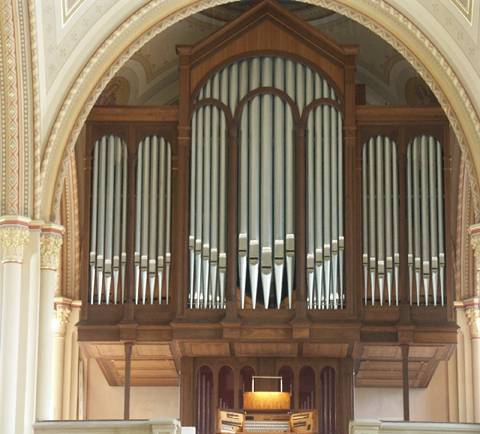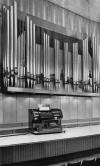Ausführliche Beschreibung der vorgewählten Orgel

Weißenhorn, Deutschland (Bayern) - Katholische Stadtpfarrkirche Mariä Himmelfahrt
Weitergeleitet von: München - Hochschule für Musik (1959 - 1998)
Gemeinde: Weißenhorn
Region:Oberpfalz
Adresse: Kirchplatz 3, 89264, Weißenhorn
Website: http://www.pfarrei-weissenhorn.de/
Beschreibung nr.: 2000989.
Gebaut von: G.F. Steinmeyer und Co. (1959) - Opus 1965
Kurze Übersicht der Orte, an denen die Orgel gestanden hat
Technische Daten
Disposition
Hauptwerk (C-g'''): Bordun 16' - 2004, Prinzipal 8', Gedackt 8', Violflöte 8', Oktave 4', Rohrflöte 4', Oktave 2', Rauschpfeife 2 fach (2 2/3'+2'), Kornett 3-5 fach (8') (from g°), Mixtur 4-6 fach (1 1/3'), Trompete 8'.
Positiv (C-g'''): Gedackt 8', Quintade 8', Prinzipal 4', Gedacktflöte 4', Waldflöte 2', Quinte 1 1/3', Sesquialtera 2 fach (2 2/3'+1 3/5'), Scharff 4 fach (2/3'), Rankett 16', Krummhorn 8', Regal 4', Tremulant.
Schwellwerk (C-g'''): Rohrgedackt 16', Holzflöte 8', Schweizerpfeife 8', Schwebung 8', Weitprinzipal 4', Koppelflöte 4', Quinte 2 2/3', Flachflöte 2', Sifflöte 1', Hintersatz 6 fach (2'), Enge Trompete 16', Schweizer Trompete 8', Oboe 8', Trompete 4', Tremulant.
Pedal (C-f'): Prinzipalbass 16', Subbass 16', Streichbass 16', Quinte 10 2/3', Oktavbass 8', Flötbass 8', Gemshorn 8', Choralbass 4', Rohrpfeife 2', Basskornett 4 fach (5 1/3'), Mixtur 6 fach (2'), Posaune 16', Trompete 8'.
Cantus-firmus-Pedal: Nachthorngedackt 4', Dulzian 16', Trompete 4', Cornett 2', Tremulant.
Koppeln: Hauptwerk - Positiv, Hauptwerk - Schwellwerk, Positiv - Schwellwerk, Pedal - Hauptwerk, Pedal - Positiv, Pedal - Schwellwerk.
Nebenregister und Spielhilfen: 3 freie Kombinationen, 1 freie Pedalkombination.

Weißenhorn, Deutschland (Bayern) - Katholische Stadtpfarrkirche Mariä Himmelfahrt
Weitergeleitet von: München - Hochschule für Musik (1959 - 1998)
Gemeinde: Weißenhorn
Region:Oberpfalz
Adresse: Kirchplatz 3, 89264, Weißenhorn
Website: http://www.pfarrei-weissenhorn.de/
Beschreibung nr.: 2000989.
Gebaut von: G.F. Steinmeyer und Co. (1959) - Opus 1965
| Jahr | Orgelbauer | Opus | Aktivität | 1959 | G.F. Steinmeyer und Co. | 1965 | Neubau | 1982 | Georg Jann | Umbau | 2004 | Klais Orgelbau | 1827 | Übersetzung |
- In 1958/1959 the Steinmeyer company built a large organ in the concert hall of the Hochschule für Musik. The organ has opus number 1965. The Schwellwerk was placed in the side wall of the stage.
- During a restoration by Georg Jann in the years 1981-1982, a new console was installed, that was mobile and is equipped with 16 Setzer combinations. But in 1998, the organ was replaced by a new instrument.
- The Steinmeyer organ was dismantled and completely overhauled by the Klais company. After that it was placed in the Mariä-Himmelfahrtkirche in Weißenhorn. Klais built a new organ case to match the interior of the church building. The specification has been restored to its original state. For this, pipe work by Sandtner was used, from the previous organ of the church in Weißenhorn. The Taschenladen have also been restored. On October 17, 2004 the organ was dedicated on the new location.
Kurze Übersicht der Orte, an denen die Orgel gestanden hat
| 1959 | München | Hochschule für Musik und Theater (Maxvorstadt), Konzertsaal |
| 2004 | Weißenhorn | Katholische Stadtpfarrkirche Mariä Himmelfahrt |
Technische Daten
| Anzahl Register pro Manual | |
| - Hauptwerk | 11 |
| - Positiv | 11 |
| - Schwellwerk | 14 |
| - Pedal | 17 |
| Gesamtzahl der Stimmen | 53 |
| Tastentraktur | Electropneumatic |
| Registertraktur | Electropneumatic |
| Windlade(n) | Taschenladen |
Disposition
Hauptwerk (C-g'''): Bordun 16' - 2004, Prinzipal 8', Gedackt 8', Violflöte 8', Oktave 4', Rohrflöte 4', Oktave 2', Rauschpfeife 2 fach (2 2/3'+2'), Kornett 3-5 fach (8') (from g°), Mixtur 4-6 fach (1 1/3'), Trompete 8'.
Positiv (C-g'''): Gedackt 8', Quintade 8', Prinzipal 4', Gedacktflöte 4', Waldflöte 2', Quinte 1 1/3', Sesquialtera 2 fach (2 2/3'+1 3/5'), Scharff 4 fach (2/3'), Rankett 16', Krummhorn 8', Regal 4', Tremulant.
Schwellwerk (C-g'''): Rohrgedackt 16', Holzflöte 8', Schweizerpfeife 8', Schwebung 8', Weitprinzipal 4', Koppelflöte 4', Quinte 2 2/3', Flachflöte 2', Sifflöte 1', Hintersatz 6 fach (2'), Enge Trompete 16', Schweizer Trompete 8', Oboe 8', Trompete 4', Tremulant.
Pedal (C-f'): Prinzipalbass 16', Subbass 16', Streichbass 16', Quinte 10 2/3', Oktavbass 8', Flötbass 8', Gemshorn 8', Choralbass 4', Rohrpfeife 2', Basskornett 4 fach (5 1/3'), Mixtur 6 fach (2'), Posaune 16', Trompete 8'.
Cantus-firmus-Pedal: Nachthorngedackt 4', Dulzian 16', Trompete 4', Cornett 2', Tremulant.
Koppeln: Hauptwerk - Positiv, Hauptwerk - Schwellwerk, Positiv - Schwellwerk, Pedal - Hauptwerk, Pedal - Positiv, Pedal - Schwellwerk.
Nebenregister und Spielhilfen: 3 freie Kombinationen, 1 freie Pedalkombination.
| Übrige dispositiondaten | |
|---|---|
| Mehrere dispositionen |
The specification of the organ was in Munich in 1998: Hauptwerk: Prinzipal 8', Gedackt 8', Violflöte 8', Oktave 4', Rohrflöte 4', Oktave 2', Rauschpfeife 2 fach (2 2/3'), Kornett 3-5 fach (8') (vanaf g), Mixtur 4-6 fach (1 1/3'), Fagott 16', Trompete 8'. Positiv: Gedackt 8', Quintade 8', Prinzipal 4', Gedackt 4', Waldflöte 2', Quinte 1 1/3', Sesquialtera 2 fach (2 2/3'), Scharff 4 fach (2/3'), Rankett 16', Krummhorn 8', Regal 4', Tremulant. Schwellwerk: Rohrgedeckt 16', Holzflöte 8', Schweizerpfeife 8', Schwebung 8', Weitprinzipal 4', Koppelflöte 4', Quinte 2 2/3', Flachflöte 2', Sifflöte 1', Hintersatz 5 fach (2'), Enge Trompete 16', Schweizer Trompete 8', Oboe 8', Trompete 4', Tremulant. Pedal: Prinzipalbass 16', Subbass 16', Streichbass 16', Quinte 10 2/3', Oktavbass 8', Flötbass 8', Gemshorn 8', Choralbass 4', Nachthorn 4' - Cantus-firmus-Pedal, Rohrpfeife 2', Basskornett 4 fach (5 1/3'), Mixtur 6 fach (2'), Posaune 16', Dulzian 16' - Cantus-firmus-Pedal, Trompete 8', Trompete 4' - Cantus-firmus-Pedal, Cornett 2' - Cantus-firmus-Pedal, Tremulant - Cantus-firmus-Pedal. Couplers: Hauptwerk - Positiv, Hauptwerk - Schwellwerk, Positiv - Schwellwerk, Pedal - Hauptwerk, Pedal - Positiv, Pedal - Schwellwerk. Accessories: 3 freie Kombinationen, 1 freie Pedalkombination. |
| Literatur |
|
| Aufnahmen |
|
| Weblinks |
https://orgelbau-klais.com/m.php?sid=40 |
 |
